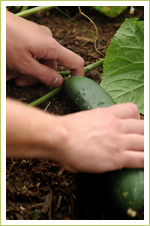Harvesting vegetables in prime time – savor the flavors!
Joe Lamp’l Executive Producer and Host | Growing a Greener World

Harvesting vegetables at their peak of freshness comes down to two things: experience and good timing. With so many things to grow, how do you know the best time for harvesting?
Start with days to maturity. It’s listed on seed packs and plant tags and will depend on if the variety is planted in the garden from seed or from transplant. Due to the amount of variables involved, these dates are not set in stone, but they are a good starting point.
Stick to the mantra “sooner rather than later.” Fortunately, certain crops like tomatoes, beets and cucumbers will continue to ripen after picking. Others start to change their flavor profile the moment they’re picked. Corn is the classic example of a variety that is best enjoyed right off the stalk. Fruit such as cucumbers and okra become bitter or woody by waiting even a day to harvest. All the more reason I prefer to have fruit in my kitchen ripening rather than rotting.
Remember, don’t force the issue. If fruit you pick seems unwilling to separate from the plant, think twice. Most fruit that’s truly ripe and ready for harvest will yield to only slight force. I take a fruit’s reluctance to separate as a sign to come back another day.
Know your fruit’s true colors. Although many specialty and heirloom varieties have unique coloring, get to know the true color at maturity for whatever you’re growing and let that help guide you. Having said that, did you know that all sweet green peppers will eventually turn red, purple or yellow if left on the plant? As a green pepper, the taste is fine but if left to change color, the taste is much more rewarding.
I’m a firm believer in “you have to grow it to know it.” There is no rule of thumb for all that grows in our gardens, but a few generalities can be relied upon when selecting the best window for picking. When it comes to gardening, there is no better way to learn than from your own mistakes, so embrace each one, because as long as you’re learning from them, you’re becoming a better, smarter gardener every day.